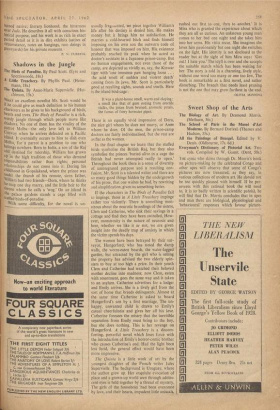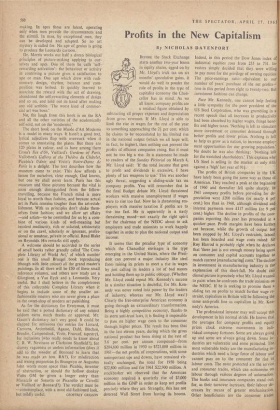Sweet Shop of the Arts
The Biology of Art. By Desmond Morris. (Methuen, 36s.) THE cynic who skims through Dr. Morris's book on picture-making by the celebrated Congo and other apes will observe that some of Congo's, 'pictures arc now treasured, as they say, in various collections of modern art. He should not be too quickly pleased with himself. If he per- severes with this rational book (he will need to, it is so badly written in scientific patois), he will find that Dr. Morris concludes that in apes and man there are biological, physiological and 'behavioural' responses which favour picture-
making. In apes these are latent, operating only when men provide the circumstances and the stimuli. In man, by exceptional men, they can be developed and adapted. So no art mystery is called for. No ape of genius is going to produce the Leonardo cartoon.
Dr. Morris works out half a dozen biological • principles of picture-making applying to our- selves and apes. One of them he calls 'self- rewarding activation': the behaviour or activity in contriving a picture gives a satisfaction to ape or man. One ape which drew with rudi- mentary design, rhythm, balance and com- position was bribed. It quickly learned to associate the reward with the act of drawing, abandoned the self-rewarding elements of design and so on, and held out its hand after making any old scribble. 'The worst kind of commer- cial art was born.'
No, the laugh from this book is on the RA and all the other varieties of the academically self-sold, not on the 'modernist.'
The short book on the Musee d'Art Moderne is a model in many ways. It hasn't a good text, lyrical adjectives flop with overwork when it comes to annotating the plates. But there are 120 plates in colour, and to have among them Cross's Iles d'Or, Vuillard's Gardens of Paris, Vallotton's Gallery at the Theatre du Chatelet, Picabia's Udnie and Vivin's Notre-Dame de Paris is a delight. The text describes how the museum came to exist. This how affords a lesson for ourselves, clear enough, God knows, but one we shall never learn. Paris has this museum and these pictures because the vital is soon enough distinguished from the fellow- travelling, because the French mind is more loyal to worth than fashion, and because actual art in Paris remains tougher than the art-estab- lishment. With us principles don't shake them- selves from fashion; and we allow art affairs —and artists—to be controlled for us by a com- bine of various kinds of well-meaning but insolent mediocrity, rich or salaried, aristocratic or on the crawl, scholarly or ignorant, profes- sional or amateur, private or official. Read Blake on Reynolds. His remarks still apply.
A welcome should be accorded to the series of small books rather grandly called 'The Com- plete Library of World Art,' of which number one is this small Bruegel . book reproducing (though with little colour) all the grand master's paintings. In all there will be 150 of these small reference volumes, and others now ready are a Giorgione, a Van Eyck and a Leonardo. Very useful. But I shall believe in the completeness of this collectable Complete Library when it begins to include some of the smaller un- fashionable masters who are never given a place in the sweet-shop of modern art publishing.
As for the dictionary for Everyman, it must be said that a potted dictionary of any subject seldom earns much thanks or approval. Mr. Gaunt's dictionary isn't very good. It could be slapped for omissions (no entries for Liotard,
Carstens, Arcimboldi, Agasse, Dahl, Blechen, Bresdin, Campendonk, Vivin, Frueauf, tapestry), for inclusions (who really needs to know about C. R. W. Nevinson or Clarkston Stanfield?), for clumsy vagueness or useless information (does it add to the wonder of Bonnard to learn that he was made an hon. RA?), for misdirection and wrong proportion (is Brangwyn or Augustus John worth more space than Picabia, inventor of abstraction, or should the hollow donkey Watts OM be given a longer entry than Masaccio or Sassetta or Pisanello or Crivelli or Vuillard or Bonnard?). The verdict must be —commonplace, with a most old-fashioned look,















































 Previous page
Previous page